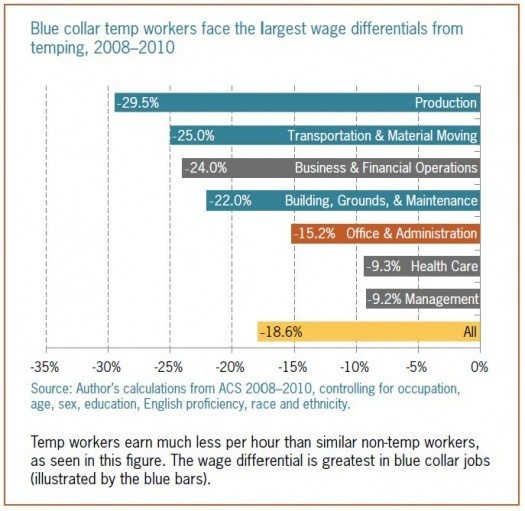Labor & Economy
Report: Temporary Employees, Permanent Poverty

The nature of employment is changing. Employees are increasingly seen as liabilities rather than assets, and so workers are kept at arm’s length from the companies they ultimately serve. Middle-class long-term jobs are shifting to precarious, low-wage work. These contingent relationships include temporary and subcontracted workers, whose ranks have been growing over the past two decades.
In California, almost one-quarter of a million people worked in the temporary help services industry in 2010; another 37,000 people worked for employee leasing firms totaling 282,000 workers in these two industries. This accounted for approximately 2.0 percent of all non-farm employment in California in 2010, approximately the same ratio as for the U.S. as whole. Employment services workers span a wide range of occupations, from professional white collar occupations like nursing, accounting, and computer programming, to blue collar work in transportation and material moving, housekeeping and landscaping, and manufacturing.
Temporary workers face lower wages, fewer benefits, and less job security. Temporary and contingent work by its very definition is less secure than full-time direct hire work. This lack of stability has implications for workers’ wealth, health and well-being. Temporary workers are not compensated for their willingness to accept less reliable work; instead they tend to face lower wages than their non-temp counterparts. Median hourly wages were $13.72 for temps and $19.13 for non-temps in California in 2008-2010. Controlling for the type of occupation as well as personal characteristics of workers such as age, education, race, sex, and English proficiency, temps make about 18 percent less per hour than their non-temp counterparts. The wage differential is even larger for blue-collar workers.
Temporary and subcontracted work presents two basic public policy problems:
- Temporary and subcontracted arrangements erode wages. These lowered wages mean that contingent workers rely more on the state safety net. Temps in California were twice as likely as non-temps to live in poverty, receive food stamps, and be on Medicaid.
- Temporary and subcontracted arrangements undermine existing worker protections first by allowing employers to avoid certain worker provisions, and second by making enforcement of the remaining protections difficult. The ability of some employers to avoid paying into the system of employer-provided worker benefits disadvantages both high-road employers who hire directly, and contingent workers who receive only limited worker protections. Even these more limited worker protections can be elusive for contingent workers who are particularly susceptible to employer retaliation.
Solutions to the problems of temporary and subcontracted work range from efforts to increase low wages generally to mandates to pay temps and non-temps the same wage. In addition, policies to combat retaliation and hold other actors in the supply chain accountable are promising ways to uphold existing worker protections in the face of workplace changes.
Miranda Dietz is a research data analyst at the U.C. Berkeley Center for Labor Research and Education. Her post first appeared on Labor’s Edge and is republished here with permission.
-

 State of InequalityApril 4, 2024
State of InequalityApril 4, 2024No, the New Minimum Wage Won’t Wreck the Fast Food Industry or the Economy
-

 State of InequalityApril 18, 2024
State of InequalityApril 18, 2024Critical Audit of California’s Efforts to Reduce Homelessness Has Silver Linings
-

 State of InequalityMarch 21, 2024
State of InequalityMarch 21, 2024Nurses Union Says State Watchdog Does Not Adequately Investigate Staffing Crisis
-

 Latest NewsApril 5, 2024
Latest NewsApril 5, 2024Economist Michael Reich on Why California Fast-Food Wages Can Rise Without Job Losses and Higher Prices
-

 California UncoveredApril 19, 2024
California UncoveredApril 19, 2024Los Angeles’ Black Churches Join National Effort to Support Dementia Patients and Their Families
-

 Latest NewsMarch 22, 2024
Latest NewsMarch 22, 2024In Georgia, a Basic Income Program’s Success With Black Women Adds to Growing National Interest
-

 Latest NewsApril 8, 2024
Latest NewsApril 8, 2024Report: Banks Should Set Stricter Climate Goals for Agriculture Clients
-

 Striking BackMarch 25, 2024
Striking BackMarch 25, 2024Unionizing Planned Parenthood






















